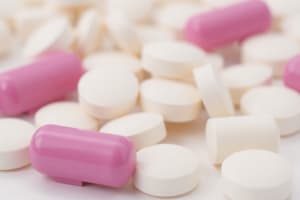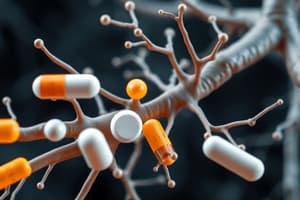Podcast
Questions and Answers
What is the primary action of Tricyclic Antidepressants?
What is the primary action of Tricyclic Antidepressants?
- Suppress rapid neuron firing
- Induce sedation
- Increase levels of norepinephrine and serotonin (correct)
- Block the action of acetylcholine (correct)
What is the purpose of Antidepressants?
What is the purpose of Antidepressants?
- Induce sleep
- Treat psychosis
- Prevent or treat depression (correct)
- Treat epileptic seizures
What condition do Antipsychotics primarily treat?
What condition do Antipsychotics primarily treat?
Psychosis
What is the primary function of Sedative-hypnotics?
What is the primary function of Sedative-hypnotics?
What do Anticonvulsants treat?
What do Anticonvulsants treat?
What is the action of Antiparkinsons?
What is the action of Antiparkinsons?
Examples of Tricyclic Antidepressants include: __________.
Examples of Tricyclic Antidepressants include: __________.
Monoamine Oxidase Inhibitors (MAOIs) block the action of __________.
Monoamine Oxidase Inhibitors (MAOIs) block the action of __________.
Examples of MAO Inhibitors include: __________.
Examples of MAO Inhibitors include: __________.
What do Selective Serotonin Reuptake Inhibitors aim to improve?
What do Selective Serotonin Reuptake Inhibitors aim to improve?
Examples of Selective Serotonin Reuptake Inhibitors include: __________.
Examples of Selective Serotonin Reuptake Inhibitors include: __________.
Examples of Miscellaneous Agents include: __________.
Examples of Miscellaneous Agents include: __________.
What do Low Potency Conventional Antipsychotics primarily treat?
What do Low Potency Conventional Antipsychotics primarily treat?
Examples of Low Potency Conventional Antipsychotics include: __________.
Examples of Low Potency Conventional Antipsychotics include: __________.
Examples of Intermediate Potency Conventional Antipsychotics include: __________.
Examples of Intermediate Potency Conventional Antipsychotics include: __________.
Examples of High Potency Conventional Antipsychotics include: __________.
Examples of High Potency Conventional Antipsychotics include: __________.
What distinguishes Atypical Antipsychotics from typical antipsychotics?
What distinguishes Atypical Antipsychotics from typical antipsychotics?
Examples of Atypical Antipsychotics include: __________.
Examples of Atypical Antipsychotics include: __________.
What is the role of Benzodiazepines?
What is the role of Benzodiazepines?
Examples of Benzodiazepines include: __________.
Examples of Benzodiazepines include: __________.
What are Nonbenzodiazepines used for?
What are Nonbenzodiazepines used for?
Examples of Nonbenzodiazepines include: __________.
Examples of Nonbenzodiazepines include: __________.
Flashcards are hidden until you start studying
Study Notes
Tricyclic Antidepressants
- Increase norepinephrine and serotonin levels, while blocking acetylcholine action.
- Alleviate depression by restoring neurotransmitter balance.
Antidepressants
- Used to prevent or treat depression and mood disorders.
- Increase levels of excitatory neurotransmitters in the brain.
Antipsychotics
- Treat psychosis and bipolar disorder.
- Block receptors in dopamine pathways and target various receptors.
Sedative-Hypnotics
- Induce sedation and sleep by depressing the central nervous system.
Anticonvulsants
- Treat epileptic seizures by suppressing excessive neuron firing.
Antiparkinsons
- Relieve Parkinson's disease symptoms.
- Increase dopamine activity or reduce acetylcholine activity in the central nervous system.
Tricyclic Antidepressants Examples
- Elavil, Pamelor (nortriptyline), Vivactil (protriptyline), Trofranil (imipramine).
Monoamine Oxidase Inhibitors (MAOIs)
- Block monoamine oxidase action to accumulate monoamines like norepinephrine.
MAO Inhibitors Examples
- Marplan (osocarboxazid), Nardil (phenelzine), Parnate (tranylcypromine).
Selective Serotonin Reuptake Inhibitors (SSRIs)
- Allow serotonin neurotransmitter to be used more effectively.
SSRIs Examples
- Prozac, Paxil, Zoloft, Celexa, Lexapro, Luvox (fluvoxamine).
Miscellaneous Antidepressants
- Examples include Serzone (nefazodone), Desyrel, Effexor, Wellbutrin (Zyban), Remeron.
Low Potency Conventional Antipsychotics
- Developed in the 1950s, primarily used for psychosis treatment.
Low Potency Conventional Antipsychotics Examples
- Thorazine (chlorpromazine), Mellaril (thioridazine).
Intermediate Potency Conventional Antipsychotics Examples
- Trilafon (perphenazine), Loxitane (loxapine).
High Potency Conventional Antipsychotics Examples
- Stelazine (trifluoperazine), Prolixin (fluphenazine), Navane (thiothixene), Haldol (haloperidol).
Atypical Antipsychotics
- Function differently from conventional antipsychotics, targeting serotonin and dopamine receptors.
Atypical Antipsychotics Examples
- Clozaril (clozapine), Zyprexa (olanzepine), Risperdal (risperidone), Seroquel, Geodon (ziprasidone), Abilify.
Benzodiazepines
- Relieve nervousness and tension by slowing the central nervous system.
Benzodiazepines Examples
- Xanax, Valium, Ativan, Serax (oxazepam), Prosom (estazolam), Restoril.
Nonbenzodiazepines
- Psychoactive drugs with actions similar to benzodiazepines but chemically distinct.
Nonbenzodiazepines Examples
- Buspar, Ambien, Sonata (zaleplon), Aquachloral (chloral hydrate).
Barbiturates
- Class of sedative-hypnotics that depress the central nervous system for various therapeutic uses.
Studying That Suits You
Use AI to generate personalized quizzes and flashcards to suit your learning preferences.




